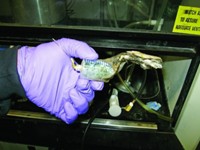Advertisement
Grab your lab coat. Let's get started
Welcome!
Welcome!
Create an account below to get 6 C&EN articles per month, receive newsletters and more - all free.
It seems this is your first time logging in online. Please enter the following information to continue.
As an ACS member you automatically get access to this site. All we need is few more details to create your reading experience.
Not you? Sign in with a different account.
Not you? Sign in with a different account.
ERROR 1
ERROR 1
ERROR 2
ERROR 2
ERROR 2
ERROR 2
ERROR 2
Password and Confirm password must match.
If you have an ACS member number, please enter it here so we can link this account to your membership. (optional)
ERROR 2
ACS values your privacy. By submitting your information, you are gaining access to C&EN and subscribing to our weekly newsletter. We use the information you provide to make your reading experience better, and we will never sell your data to third party members.
Lab Safety
Researcher Dies After Lab Fire
UCLA research assistant burned in incident with tert-butyl lithium
by Jyllian Kemsley
January 22, 2009
A research assistant in the University of California, Los Angeles, department of chemistry and biochemistry died on Jan. 16 from injuries sustained in a laboratory fire that occurred in December, the university has confirmed.
UCLA officials declined to provide C&EN with specific details of the incident, pending an investigation. But according to a Dec. 30, 2008, e-mail to C&EN from department chair Albert J. Courey, university investigators believe that on Dec. 29, Sheharbano Sangji, 23, was drawing tert-butyl lithium (t-BuLi) from a bottle into a syringe when the plunger came out of the syringe barrel. The chemical, which ignites spontaneously in air, splashed onto Sangji's clothes and set them on fire. Sangji was burned on her hands, arms, and upper torso, for a total of 40% of her body. After initial treatment at Ronald Reagan UCLA Medical Center, she was transferred to the Grossman Burn Center in Sherman Oaks, Calif., where she died.
An unconfirmed description of the accident was posted on Jan. 7 to the ACS Division of Chemical Health & Safety e-mail list by Debbie M. Decker, a member of the division and a UC Davis chemical safety officer. It says that Sangji was wearing safety glasses, a sweater made of synthetic material, nitrile gloves, and no lab coat and that the t-BuLi ignited her sweater and gloves.
Synthetic materials such as polyester are "analogous to solid gasoline," says Neal Langerman, the founder of the company Advanced Chemical Safety and a consultant to the ACS Committee on Chemical Safety. "Once it ignites, it burns just like a hydrocarbon, so it really is inappropriate lab apparel by itself." A lab coat might have prevented the sweater from igniting and reduced the extent of Sangji's injuries, he says, although he emphasizes that he is speculating. Fire-resistant gloves are also available, Langerman says, although they are bulky and reduce dexterity, which can also lead to accidents. "That problem hasn't been adequately solved," he adds.
Sangji graduated from Pomona College in May 2008. She was working at UCLA while applying to law school, says her former adviser at Pomona, chemistry professor Daniel J. O'Leary, who is now at Bowdoin College. Sangji spent three years working on peptide chemistry in O'Leary's lab. "She was just a wonderful person," O'Leary says. "Many, many people are mourning her loss."
When asked whether he is reconsidering safety procedures in his lab at Bowdoin, O'Leary says, "Just about every organic chemist works with hazardous and dangerous things. This can only serve as a wake-up call to redouble efforts to be safe."
The incident remains under investigation by the California Division of Occupational Safety & Health and the Office of the State Fire Marshal, says James Gibson, director of UCLA's Office of Environment, Health & Safety.







Join the conversation
Contact the reporter
Submit a Letter to the Editor for publication
Engage with us on Twitter